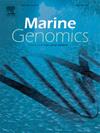Comparative metagenomic analyses of the microbiome from three Mediterranean sponges to identify genes involved in biosynthesis of bioactive compounds
IF 1.5
4区 生物学
Q4 GENETICS & HEREDITY
引用次数: 0
Abstract
Marine sponges host a range of microorganisms and among them, bacteria represent a significant part of their biomass. Furthermore, bacteria are promising sources of natural products to be applied in various fields. Often the study their biotechnological potential is relented by low grow rates. For this reason, such cultivation-independent approaches, as metagenomics tools applied to sponges is obtaining wide success. For the first time, here we aimed at having an almost complete information about taxonomic and functional diversity of bacteria associated to three sponges, Agelas oroides, Haliclona (Halichoclona) vansoesti and Geodia cydonium, previously reported as candidate sources of bioactive compounds for pharmacological, nutraceutical and cosmeceutical purposes. Comparative metagenomic analyses were applied, sequencing DNA from the three sponges by ONT GridION X5 Mk1 sequencer. Our findings revealed for all the analyzed sponges the presence of genes/enzymes responsible for the synthesis of vitamins, fatty acids, antioxidant glutathione, terpenes, steroids and carotenoids. Consequently, we demonstrated the three sponges under analysis and their associated microorganisms could be considered good candidates for the isolation and identification of bioactive compounds for biotechnological application in the field of pharmacology, nutraceuticals and cosmeceuticals as well as environmental biotechnologies. Overall, metagenomic data represent a useful tool exploitable to sustainably develop bioactive products.
对三种地中海海绵微生物组进行宏基因组比较分析,以确定参与生物活性化合物生物合成的基因
海洋海绵是一系列微生物的宿主,其中细菌占其生物量的很大一部分。此外,细菌是很有前景的天然产物来源,可应用于各个领域。对它们的生物技术潜力的研究往往因生长速度低而受到影响。因此,这种与培养无关的方法,如宏基因组学工具在海绵上的应用正在取得广泛的成功。本文首次对三种海绵(Agelas oroides, Haliclona (Halichoclona) vansoesti和Geodia cydonium)相关细菌的分类和功能多样性进行了研究,这三种海绵在药理、营养和药妆方面被认为是生物活性化合物的候选来源。采用比较宏基因组分析,使用ONT GridION X5 Mk1测序仪对3种海绵进行DNA测序。我们的研究结果显示,所有被分析的海绵中都存在负责合成维生素、脂肪酸、抗氧化剂谷胱甘肽、萜烯、类固醇和类胡萝卜素的基因/酶。因此,我们证明了所分析的三种海绵及其相关微生物可以被认为是分离和鉴定生物活性化合物的良好候选者,可用于药理学,保健品和药妆以及环境生物技术领域的生物技术应用。总体而言,宏基因组数据是可持续开发生物活性产品的有用工具。
本文章由计算机程序翻译,如有差异,请以英文原文为准。
求助全文
约1分钟内获得全文
求助全文
来源期刊

Marine genomics
生物-遗传学
CiteScore
3.60
自引率
5.30%
发文量
50
审稿时长
29 days
期刊介绍:
The journal publishes papers on all functional and evolutionary aspects of genes, chromatin, chromosomes and (meta)genomes of marine (and freshwater) organisms. It deals with new genome-enabled insights into the broader framework of environmental science. Topics within the scope of this journal include:
• Population genomics and ecology
• Evolutionary and developmental genomics
• Comparative genomics
• Metagenomics
• Environmental genomics
• Systems biology
More specific topics include: geographic and phylogenomic characterization of aquatic organisms, metabolic capacities and pathways of organisms and communities, biogeochemical cycles, genomics and integrative approaches applied to microbial ecology including (meta)transcriptomics and (meta)proteomics, tracking of infectious diseases, environmental stress, global climate change and ecosystem modelling.
 求助内容:
求助内容: 应助结果提醒方式:
应助结果提醒方式:


